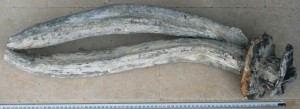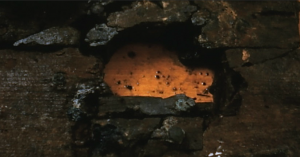 A 2000-year-old Roman shipwreck discovered off the coast of Grado, Italy in 1986 has an interesting feature: a 51-inch-long lead pipe that fits into a hole 2.7 inches in diameter drilled into the hull near the keel. Since shipwrights are not usually in the habit of poking holes into the bottom of what should be a watertight vessel, researchers at the Museum of Underwater Archaeology in Grado (where the wreck has been studied since it was recovered in 1999) have been investigating the possible uses of the hole and pipe. Last month they published a theoretical reconstruction in the International Journal of Nautical Archaeology suggesting the hole and pipe were part of a hydraulic system that would have kept oxygenated water pumping through a large aquarium, allowing the small trading vessel to carry an impressively large load of live fish.
A 2000-year-old Roman shipwreck discovered off the coast of Grado, Italy in 1986 has an interesting feature: a 51-inch-long lead pipe that fits into a hole 2.7 inches in diameter drilled into the hull near the keel. Since shipwrights are not usually in the habit of poking holes into the bottom of what should be a watertight vessel, researchers at the Museum of Underwater Archaeology in Grado (where the wreck has been studied since it was recovered in 1999) have been investigating the possible uses of the hole and pipe. Last month they published a theoretical reconstruction in the International Journal of Nautical Archaeology suggesting the hole and pipe were part of a hydraulic system that would have kept oxygenated water pumping through a large aquarium, allowing the small trading vessel to carry an impressively large load of live fish.


The ship is only 55 feet long and 19 feet wide, and 600 amphorae were found on board filled with preserved fish and fish products like the ubiquitous garum, an umami-rich fish sauce that the Romans used in pretty much every dish imaginable, including desserts. Since they had no means to refrigerate fresh fish for long haul transportation, historians have thought that people ate fish within easy reach of where they were caught. Ancient sources, however, do claim that live fish were transported over long distances. Pliny, for example, in Book 9 of his Natural History describes the Emperor Claudius’s fleet commander collecting live parrotfish (scarus in Latin, a great delicacy considered superior to other fish because it supposedly ruminated on grasses instead of eating other fish) from the Black Sea and bringing them back to the Mediterranean to release them into the wild and create a local population. Pliny says it worked, too.
 Carlo Beltrame, a marine archaeologist at the Ca’ Foscari University of Venice in Italy, and his colleagues believe the lead pipe was connected to a hand-operated piston pump that, through a series of one-way valves, pulled water from the ocean into a live fish tank. The research team calculated that the pump could have supported a flow of 66 gallons (252 liters) of water per minute. There was space behind that ship’s mast and sufficient structural capability to support an aquarium measuring 11.4 feet by 6.5 feet by 3.3 feet holding 140 cubic feet of water. A tank that size would need to have its water refreshed every half hour to ensure the survival of the fish. The piston pump would have been able to completely replace the water every 16 minutes, so the pumpers would have plenty of time to spare. A tank that size could have comfortably carried 440 pounds of live fish.
Carlo Beltrame, a marine archaeologist at the Ca’ Foscari University of Venice in Italy, and his colleagues believe the lead pipe was connected to a hand-operated piston pump that, through a series of one-way valves, pulled water from the ocean into a live fish tank. The research team calculated that the pump could have supported a flow of 66 gallons (252 liters) of water per minute. There was space behind that ship’s mast and sufficient structural capability to support an aquarium measuring 11.4 feet by 6.5 feet by 3.3 feet holding 140 cubic feet of water. A tank that size would need to have its water refreshed every half hour to ensure the survival of the fish. The piston pump would have been able to completely replace the water every 16 minutes, so the pumpers would have plenty of time to spare. A tank that size could have comfortably carried 440 pounds of live fish.
 No pump mechanism was found on the wreck, however, and the pipe was discovered nestled in a sort of small bilge-well. Why not assume the pipe would have been part of a bilge pump rather than the far more elaborate tank theory? The researchers think it’s unlikely that a ship of this size would have a complex mechanism like a bilge pump just to discharge water. Roman ships had simple bucket chain pump systems that were able to dump water out of the side of the ship easily and safely. If they were going to use a bilge pump system, they’d have to have a damn good reason: i.e., profit.
No pump mechanism was found on the wreck, however, and the pipe was discovered nestled in a sort of small bilge-well. Why not assume the pipe would have been part of a bilge pump rather than the far more elaborate tank theory? The researchers think it’s unlikely that a ship of this size would have a complex mechanism like a bilge pump just to discharge water. Roman ships had simple bucket chain pump systems that were able to dump water out of the side of the ship easily and safely. If they were going to use a bilge pump system, they’d have to have a damn good reason: i.e., profit.
Even if we accept for the sake of argument that there was a piston pump on board, how do we know it was there to feed a live fish tank? Such pumps have been used even up until the 19th century to clean decks and extinguish fires as well. The research team doesn’t think that’s a likely use in this case simply because the ship was too small and innocuous to require so elaborate a system for cleaning or in case of fire. That’s more the kind of thing you’d find on a warship.
According to Rita Auriemma, a marine archaeologist at the University of Salento, it is plausible that the hydraulic system in Grado ship served for live fish trade.
“The context in which the ship operated makes this the most logical explanation,” Auriemma told Discovery News.
“The near Istria coast was known for numerous vivaria, large enclosures to breed fish. It is possible that the Grado ship transported live fish from these vivaria to large markets in the high Adriatic,” Auriemma said.
Indeed, it would have taken about 10 hours to cross the nearly 30 miles of sea that divided the Istria vivaria to the river port of Aquileia, one of the richest Roman towns during the imperial period.
“Such a trip could have been sustained by the live fish only through an apparatus of continuous water exchange similar to that of the Grado ship,” Beltrame said.
Still, there isn’t a great deal of hard archaeological evidence supporting this theory. The research team’s next step is to attempt to recreate the pump and tank system to see if it would have worked in practice. If it turns out to be true that a small workhorse like the Grado ship routinely carried live fish, this will revolutionize historians’ understanding of Roman trade.
It seems to me that there are too many unknowns to support a conclusion, even if they are able to construct a device that does what they say. The fact that it might be possible and make sense, doesn’t confirm that it was actually so.
I agree. They are speculating way beyond the evidence at hand about this boat. It seems like the goal is to be the first to find “proof” for ancient accounts that have thus far never been verified.
I think you guys are being a bit hard on them. Sure, I guess it’s not verified. But it’s a very interesting clue, and really it’s got to be something really interesting. You don’t drill a hole in your hull for shits n giggles. Something interesting was going on. Shipping live fish fits into the historical documentation and makes a lot of sense.
In an ancient world where people were building the Anikythera mechanism, it seems like a pretty mundane idea that someone had a fish tank on a boat.
It’s not a question of what they could have done. That issue has already been posited by the researchers. The issue is what they found, which was nothing but the pipe and a hole. There is no mention whatsoever that other related objects were found in the area or have ever been found anywhere else.